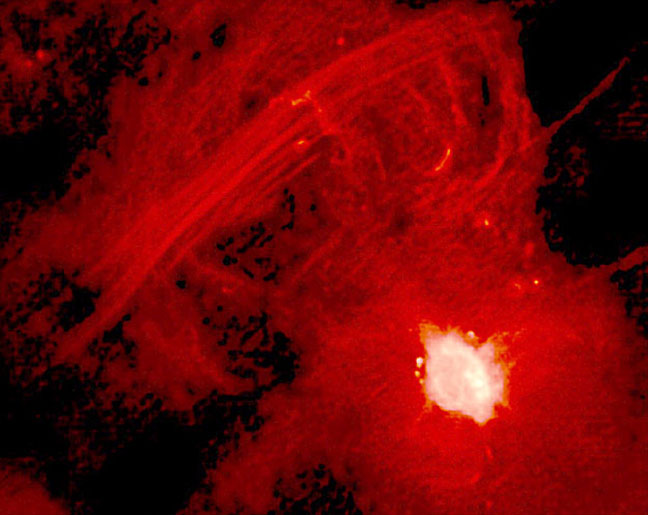
home •
about •
essential guide •
picture of the day •
thunderblogs •
news •
multimedia •
predictions •
products •
get involved •
contact
picture of the day archive subject index
Credit: Farhad Yusef-Zadeh et al. (Northwestern), VLA, NRAO
Electric Motor of the Milky WayApr 03, 2006
VLA radio telescope imagery shows the "motor" structure around the core of the Milky Way. No theorist exploring the mathematical wonders of gravitational black holes ever posited this structure. A much different thought system sees the electric force as more fundamental than gravity.
What does it take to make a galaxy? This simple question will be answered in radically different ways by two schools of thought. The popular view in astronomy today imagines that black holes and dark matter organize galactic structure and induce the observed motions. Neither can be seen, but both can be described mathematically without straying from the paradigm of an electrically neutral, gravitationally-driven cosmos.
A much different thought system sees the electric force as more fundamental than gravity. When considering new images from space, proponents of the Electric Universe emphasize structures that were never anticipated by the gravitational models but that were predicted by plasma cosmologists. As demonstrated in numerous laboratory experiments, electric currents in plasma can produce all of the common structures observed in the heavens, from simple filaments to the polar jets of stars and galaxies to the “wheels within wheels” found at the cores of nebulas and other high-energy formations.
For several years now, radio and x-ray telescopes have been taking us inside nebulas and other sources of intense energy in space to see hidden structures. Among the more striking examples are the Crab Nebula and the Vela Pulsar.
In the VLA radio telescope picture above, the bright area in the lower right is Sagittarius A, presumed to be the core of our galaxy, the Milky Way. From the mainstream point of view it hides a black hole. However, no theorist exploring the mathematical wonders of black holes ever posited the structures observed around it. But the electric viewpoint sees something much different, something that was anticipated by the experimental work of Hannes Alfven and his colleagues who founded today’s plasma cosmology.
Radio waves and x-rays are produced by electric currents.
For the electrical theorists, the modern radio and x-ray telescopes are catalysts for the evolution of cosmological ideas. By enabling us to see the Milky Way core in wavelengths not normally visible to the human eye, they reveal the “homopolar motor” that drives the Milky Way. A homopolar motor operates on direct current interacting with a strong magnetic field to produce rotary motion. The brushes which connect the rotary component to the surrounding stationary component are analogous to the “threads” which, in the picture above, reach upward to feed the motor of our galaxy.
We have covered the electric system of the Milky Way’s core in several previous Pictures of the Day as seen in the following links. A closer radio telescope view of Sagittarius A can be seen here. The anomalous “temperature variations” at the galactic core are noted here. And the relationship of the galactic core to electric currents feeding star formation is discussed here.
__________________________________________________________________________Please visit our new "Thunderblog" page
Through the initiative of managing editor Dave Smith, we’ve begun the launch of a new
page called Thunderblog. Timely presentations of fact and opinion, with emphasis on
new discoveries and the explanatory power of the Electric Universe."The Electric Sky and The Electric Universe available now!

|
|

|
EXECUTIVE EDITORS:
David Talbott, Wallace Thornhill
MANAGING EDITORS:
Steve Smith, Mel Acheson
CONTRIBUTING EDITORS: Michael Armstrong, Dwardu Cardona,
Ev Cochrane,
C.J. Ransom, Don Scott, Rens van der Sluijs, Ian Tresman
WEBMASTER: Brian Talbott
Copyright 2008: thunderbolts.info
![]()
home •
thunderblogs •
forum •
picture of the day •
resources •
team •
updates •
contact us

